
Eye med Eylea has been a blockbuster sales force for Regeneron, but Novartis’ challenger brolucizumab is on the horizon. Could a new delivery option give Eylea a leg up?
That’s what Regeneron’s hoping. The FDA Tuesday approved a new prefilled injector for 2-milligram single doses of Eylea to treat patients with wet age-related macular degeneration (AMD), macular edema following retinal vein occlusion, diabetic macular edema and diabetic retinopathy.
The drugmaker touted the new approval as a game-changer for physicians, taking multiple preparation steps out of the original vial dose regimen. Eylea is now the only drug approved to treat four retinal diseases with a single-dose prefilled injector, although Roche’s Lucentis has two prefilled injector doses that cover all four of those indications separately.
Regeneron is hoping the newest green light will help it secure its place as the top-performing wet AMD drug on the market as competitors loom.
Novartis’ brolucizumab, a wannabe rival in wet AMD, is under priority review from the FDA, and it could steal the limelight from Eylea and its only approved competitor, Roche’s Lucentis. Novartis’ drug boasts strong head-to-head data against Eylea, including wins against the older drug in reducing retinal fluid and central subfield thickness.
But Regeneron hasn’t taken that challenge sitting down. In May, Eylea received an FDA nod to treat all forms of diabetic retinopathy, a condition that affects about 8 million people worldwide and is the leading cause of blindness in U.S. adults, the company said.
That new indication helped drive Eylea sales up 17% in the second quarter to $1.16 billion. Those sales represent a significant chunk of the drugmaker’s total $1.9 billion in the quarter.
It also followed positive results from the drug’s phase 3 trial dubbed Panorama, which showed an 85% and 88% risk reduction for diabetic retinopathy patients developing proliferative diabetic retinopathy (PDR) at the one-year mark when dosing every 16 and eight weeks, respectively. Twenty percent of untreated patients developed PDR, which causes abnormal blood vessel growth on retinas and potentially vision loss, at the one-year mark, the company said.
Strong sales have been a boon for Regeneron as another pillar of its growth strategy—an antibody partnership with Sanofi on PCSK9 inhibitor Praluent and Dupixent—is just now turning a profit.
Fueled by Dupixent’s $557 million in second-quarter sales—a 166% increase—Regeneron last week reported that its Sanofi partnership posted a $39 million profit, a big turnabout from the same period last year, when it cost Regeneron $69 million.















